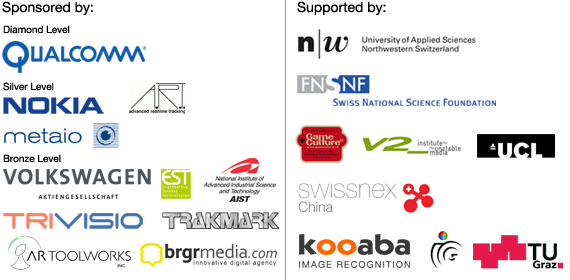Art Exhibition and Mock-ups
27 - 30 October |
|
ARt Exhibition |
Dreispitz |
|
Exhibition Informations Venue: Dreispitz Areal, Helsinkistrasse 9, Münchenstein. Contact: SHIFT – Electronic Arts Festival
OPENING HOURS Thursday 27 October 2011, 18:30 – 24:00 Friday 28 October 2011, 12:00 – 24:00 Saturday 29 October 2011, 12:00 – 24:00 Sunday 30 October 2011, 11:00 – 18:00 |
|
Cashback (2009)
Vincent Jacquier (EPFL+ECAL Lab, CVLab-EPFL), CH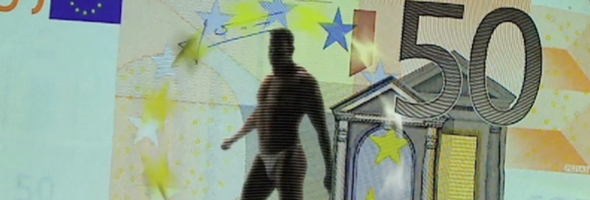
Cashback is an interactive installation that seeks to alter our perception of everyday objects and images by linking virtual content to physical reality. When users place a banknote on top of the installation, the screen reveals unexpected meanings and the ordinary object takes a whole new shade: a stripper appears on the banknote and begins provocative dance moves.
Cashback works with 5, 10, 20, 50 and 100 Euro banknotes: the higher the value of the banknote, the more 'content' the user gets to see. The different sides of the banknote also dictate what kind of stripper will appear (female or male).
The installation uses a mixed reality technology developed at the Computer Vision Laboratory of EPFL (Ecole polytechnique fédérale de Lausanne) that overcomes the use of tags, allowing the designers to work directly on the objects and their images.
Cashback works with 5, 10, 20, 50 and 100 Euro banknotes: the higher the value of the banknote, the more 'content' the user gets to see. The different sides of the banknote also dictate what kind of stripper will appear (female or male).
The installation uses a mixed reality technology developed at the Computer Vision Laboratory of EPFL (Ecole polytechnique fédérale de Lausanne) that overcomes the use of tags, allowing the designers to work directly on the objects and their images.
Geek Run (2011)
Emilie Tappolet, Maria María Beltrán, Raphaël Muñoz (HEAD Geneva), CH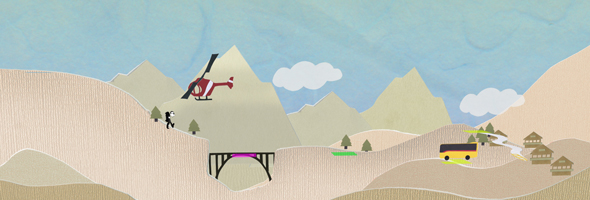
Geek Run is an interactive installation that aims to break the wall between the physical and virtual worlds by using wooden cubes as a tangible interface for a collaborative game, in combination with a Kinect controller.
The cubes do not feature any electronic technology, yet they become the interface between the player and the virtual world. By moving them on the floor in front of the Kinect, players control different functional elements on the screen. The lead character, the so-called geek, follows a series of forking paths. By placing the cubes in the correct position, the geek avoids obstacles and/or opens up a new path in the game. As in a choose-your-own-adventure book, the user’s choices open up new possibilities for gameplay. The story and the followed paths are different every time the installation is presented anew.
The cubes do not feature any electronic technology, yet they become the interface between the player and the virtual world. By moving them on the floor in front of the Kinect, players control different functional elements on the screen. The lead character, the so-called geek, follows a series of forking paths. By placing the cubes in the correct position, the geek avoids obstacles and/or opens up a new path in the game. As in a choose-your-own-adventure book, the user’s choices open up new possibilities for gameplay. The story and the followed paths are different every time the installation is presented anew.
Re: Newspaper (2010)
Akitoshi Honda, JP
Re: Newspaper is an augmented newspaper that aims to show how news is presented across the world.
Influenced by the Internet, the form and function of news reading has nowadays drastically changed. People can read real-time online news from all over the world: this results in a seemingly flat, homogeneous, globalized news feed. However, although the news content is becoming increasingly globalized, the way news is presented still widely varies among different countries and cultures.
The project Re: Newspaper aims to expand the viewer's awareness of the differences and similarities in the ways news is presented across the globe. The news content is taken from the World Wide Web and channeled to a blank physical newspaper. By interacting with this newspaper, viewers can geographically browse through the current news feeds from a variety of countries.
Influenced by the Internet, the form and function of news reading has nowadays drastically changed. People can read real-time online news from all over the world: this results in a seemingly flat, homogeneous, globalized news feed. However, although the news content is becoming increasingly globalized, the way news is presented still widely varies among different countries and cultures.
The project Re: Newspaper aims to expand the viewer's awareness of the differences and similarities in the ways news is presented across the globe. The news content is taken from the World Wide Web and channeled to a blank physical newspaper. By interacting with this newspaper, viewers can geographically browse through the current news feeds from a variety of countries.
Interstitial Space Helmet (2004)
James Auger, UK
The Interstitial Space Helmet (ISH) is an experiential comment on contemporary communication as mediated by technology. The ISH looks at the rise of digital mediation of human representation and how this challenges normative ideas of image, personality and communication.
Whilst placed in front of the screen, interacting with others via web cams and artificial personas, the modern computer user might run into problems dealing with real people in physical interactions. The concept blurs these two worlds, taking elements of the virtual into the physical.
A product for the Otaku generation, it acknowledges the fact that the Internet has created new forms of social interaction that enable new modes of behavior. Online chat rooms, games and virtual worlds such as Second Life, in which we can be whoever we choose to be, exemplify this. Normative modes of behavior and rules do not exist and for some, these places are more comfortable than the physical world.
The Interstitial Space Helmet consists of 2 standard vacuum formed halves of A.B.S. These are individually fitted to the user with an acoustic internal padding to ensure a comfortable and sound proof fit. The ISH in the standard form has one A/V output, an internal LCD screen at a distance of 17.5 cm from the eye, and an internal microphone.
Whilst placed in front of the screen, interacting with others via web cams and artificial personas, the modern computer user might run into problems dealing with real people in physical interactions. The concept blurs these two worlds, taking elements of the virtual into the physical.
A product for the Otaku generation, it acknowledges the fact that the Internet has created new forms of social interaction that enable new modes of behavior. Online chat rooms, games and virtual worlds such as Second Life, in which we can be whoever we choose to be, exemplify this. Normative modes of behavior and rules do not exist and for some, these places are more comfortable than the physical world.
The Interstitial Space Helmet consists of 2 standard vacuum formed halves of A.B.S. These are individually fitted to the user with an acoustic internal padding to ensure a comfortable and sound proof fit. The ISH in the standard form has one A/V output, an internal LCD screen at a distance of 17.5 cm from the eye, and an internal microphone.
Jekyll and Hyde (2010)
Martin Kovacovsky, Marius Hügli, CH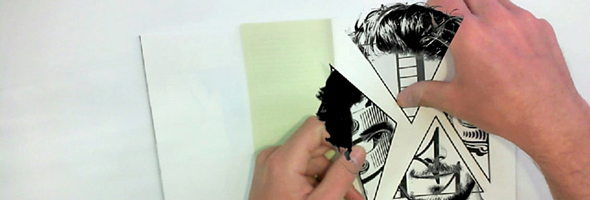
In the last decade, there has been a remarkable change in media consumption. Many of the traditional media communication channels, such as newspapers and books, are increasingly being consumed on a screen.
In their work Jekyll and Hyde Martin Kovacovsky and Marius Hügli explore and demonstrate the new possibilities offered by the use of augmented reality in the press industry. Based on the novel The Strange Case of Dr. Jekyll and Mr. Hyde, Kovacovsky and Hügli created a book that offers additional multimedia content when combined with a screen. Rather than merely placing 3D models on top of the book pages, they tried to find unusual ways to combine the analog and the digital content. Jekyll and Hyde is a collection of applications developed through a series of experiments and design studies.
In their work Jekyll and Hyde Martin Kovacovsky and Marius Hügli explore and demonstrate the new possibilities offered by the use of augmented reality in the press industry. Based on the novel The Strange Case of Dr. Jekyll and Mr. Hyde, Kovacovsky and Hügli created a book that offers additional multimedia content when combined with a screen. Rather than merely placing 3D models on top of the book pages, they tried to find unusual ways to combine the analog and the digital content. Jekyll and Hyde is a collection of applications developed through a series of experiments and design studies.
lifeClipper3 (2009 – 2010)
Jan Torpus – concept, visuals, direction, CH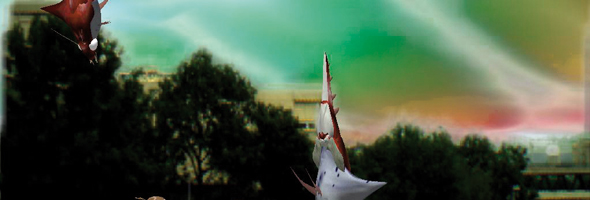
The following people were also involved in the project lifeClipper3: Vera Bühlmann – theory and philosophy | Fabien Barati – game world programming | José Navarro – sound design | Markus Braach – artificial life design | Oliver Koch – technical setup | Andreas Simon – technical support | Permi Jhooti – biofeedback setup | Pascal Bosetti & Sebastian Dittus – backpack design | Samuel Hanselmann – Website | Robin Wenger – video documentation
lifeClipper is a game-like, interactive new-media artwork, which has been implemented with immersive Augmented Reality Technologies in the St. Johanns Park in Basel, Switzerland. It invites visitors to walk around the park with a wearable computer system in order to experience alternative realities. Shifts between everyday life conventions and fantastic parallel worlds with different physical and cultural rules create interferences, and question our perception of reality.
Besides the artistic video documentation shown at the exhibition venue,lifeClipper3 offers visitors an augmented walk during ISMAR11. Visitors can make a reservation on the website http://www.lifeClipper3.torpus.com
The project was supported/funded by: Institute for Research in Art and Design HGK FHNW, Switzerland | Fachausschuss für Audiovision und Multimedia BS/BL | Christoph Merian Stiftung Basel | GGG Basel
lifeClipper is a game-like, interactive new-media artwork, which has been implemented with immersive Augmented Reality Technologies in the St. Johanns Park in Basel, Switzerland. It invites visitors to walk around the park with a wearable computer system in order to experience alternative realities. Shifts between everyday life conventions and fantastic parallel worlds with different physical and cultural rules create interferences, and question our perception of reality.
Besides the artistic video documentation shown at the exhibition venue,lifeClipper3 offers visitors an augmented walk during ISMAR11. Visitors can make a reservation on the website http://www.lifeClipper3.torpus.com
The project was supported/funded by: Institute for Research in Art and Design HGK FHNW, Switzerland | Fachausschuss für Audiovision und Multimedia BS/BL | Christoph Merian Stiftung Basel | GGG Basel
Perpendicular Cinema (2011)
Julien Maire, FRProduced by DOCK Berlin e.V. supported by the Hauptstadtkulturfonds
Electronics by Sukandar Kartadina, software by Yacine Sebdi, assistance for construction by Jana LInke
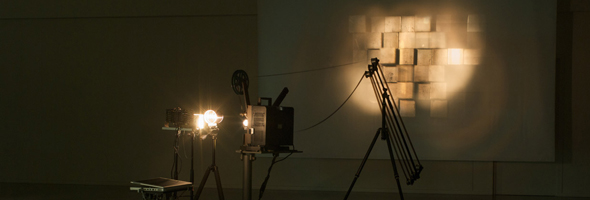
Julien Maire’s work operates at the intersection of installation, performance and media art. In his artworks and performances, Julien Maire systematically re-invents the technology of visual media. His research is a manifest hybrid between media-archeology and the production of new media. The output usually consists of prototypes that are at the same time radical and archaic. In the installation Perpendicular Cinema, for instance, 48 mirrors controlled by servo motors and custom software reflect and present found footage, questioning current visual conventions and visual strategies in the digital era.
Reverse Blinking (2010)
Ief Spincemaille, BECredits: with the support of the Flemish Autorities
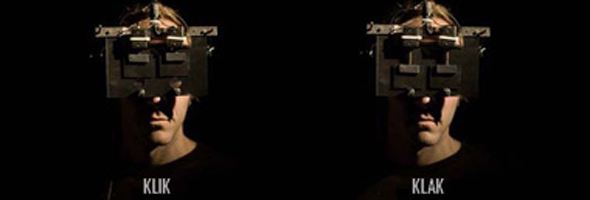
Imagine that somebody’s head is captured inside a photo camera. It is completely dark, and only when the shutter opens and closes, he or she can see the world in a flash. The shutter moves so fast that nothing has time to move. Everything he or she points his/her gaze at becomes a photograph, a memory; people become frozen figures, and life turns into some kind of slide show.
Reverse Blinking by Ief Spincemaille creates such an experience. The work consists of a completely closed helmet with two shutters positioned in front of the eyes, which open and close in 0.3 seconds and can be controlled by the user. Reverse Blinking is powered by batteries and can be used both inside and outside of the exhibition space.
Reverse Blinking is part of a series of artworks that attempt to add video and photographical effects to the way we naturally see. While virtual reality goggles try to make us believe that the images we see are real, Spincemaille’s device does exactly the opposite. The googles manipulate our vision in order to make the real environment around us look utterly unreal, as if it was an image. By doing this, the artist shows to which degree contemporary society is dominated by images: according to Spinceimaille, the world has become an image and the image has become reality.
Reverse Blinking by Ief Spincemaille creates such an experience. The work consists of a completely closed helmet with two shutters positioned in front of the eyes, which open and close in 0.3 seconds and can be controlled by the user. Reverse Blinking is powered by batteries and can be used both inside and outside of the exhibition space.
Reverse Blinking is part of a series of artworks that attempt to add video and photographical effects to the way we naturally see. While virtual reality goggles try to make us believe that the images we see are real, Spincemaille’s device does exactly the opposite. The googles manipulate our vision in order to make the real environment around us look utterly unreal, as if it was an image. By doing this, the artist shows to which degree contemporary society is dominated by images: according to Spinceimaille, the world has become an image and the image has become reality.
Sensible 1.0 (2011)
Bram Snijders, NLProduced by V2_Lab
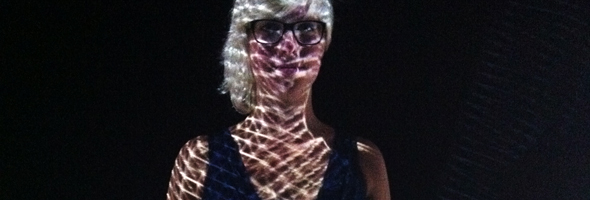
Sensible1.0 is an interactive installation that enables users to ‘sense’ a virtual layer made of digital matter within a physical space. The core of the installation is the virtual layer; it consists of a digital representation of the x, y, z coordinates of the physical space. These coordinates are captured and translated real-time into their digital counterparts.
In the installation Sensible1.0 the physical and the digital dimension overlay. Only when an object or person is positioned within the coordinates of the virtual layer, the latter is revealed by the manifestation of projected light.
In the installation Sensible1.0 the physical and the digital dimension overlay. Only when an object or person is positioned within the coordinates of the virtual layer, the latter is revealed by the manifestation of projected light.
Solace (2011)
Nicky Assmann, NL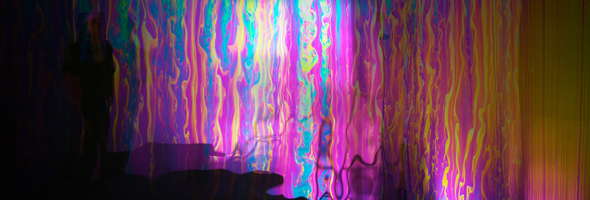
Solace is a cinematic installation that explores the mental process and physical activity of seeing. At regular intervals, a handcrafted apparatus creates a film made of soap. By means of precisely calibrated lighting the inner movement of the soap film is revealed to the viewer, showing a turbulent choreography of iridescent colors and fluid motion. Fascinated by the phenomenon, the viewer can observe in awe until gravity slowly gets a hold of the soap membrane, and the fragile film inevitably bursts.
Static (2010)
Wim JanssenProduced by Werktank
With support of the Flemish Authorities
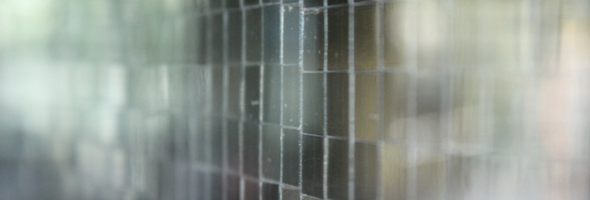
Static is an installation by Wim Janssen that focuses on the phenomenon of television static. Television static is an artifact of technology, a physical phenomenon and unwanted by-product. Wim Janssen tries to imitate and materialize static by means of an apparently slow and inefficient process.
Lightwaves, besides their frequency and amplitude, also have an orientation. A polarization filter allows light to pass through it only in one such orientation. When one looks through a piece of this filter, it appears perfectly transparent, just a bit darker than normal plexi or glass. However, when one looks at another piece of this same material through the filter, rotated at 90 degrees, the second piece becomes an opaque black surface. This happens because the light that passed through the first filter cannot pass through the second filter; every other orientation gives a different degree of opacity.
For Static, a polarization filter was cut into small rectangles of one square cm, in random orientations, as if they were large pixels. These little squares were then placed between two large rectangular pieces of plexiglass. The screen looks like a slightly darkened window. A rotating disc of the same material was also placed in the exhibition space. When the screen is seen through this disc, it turns into a half transparent field of video noise: white noise that is created entirely by the manipulation of light.
Lightwaves, besides their frequency and amplitude, also have an orientation. A polarization filter allows light to pass through it only in one such orientation. When one looks through a piece of this filter, it appears perfectly transparent, just a bit darker than normal plexi or glass. However, when one looks at another piece of this same material through the filter, rotated at 90 degrees, the second piece becomes an opaque black surface. This happens because the light that passed through the first filter cannot pass through the second filter; every other orientation gives a different degree of opacity.
For Static, a polarization filter was cut into small rectangles of one square cm, in random orientations, as if they were large pixels. These little squares were then placed between two large rectangular pieces of plexiglass. The screen looks like a slightly darkened window. A rotating disc of the same material was also placed in the exhibition space. When the screen is seen through this disc, it turns into a half transparent field of video noise: white noise that is created entirely by the manipulation of light.
The... (2011)
Kasia Molga, Brendan Oliver, UKProduced by V2_Lab
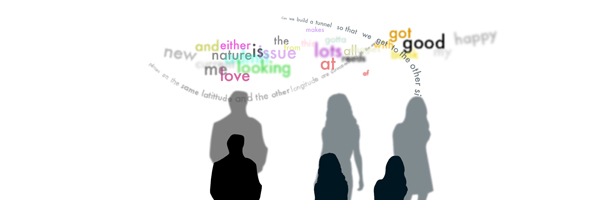
The interactive installation The... enables viewers to interact with ‘thoughts’ by casting their shadows on the wall of a gallery. Thanks to the motion and body shape sensing cameras such as Kinect, the shadows of the viewers casted on the walls will be able to engage into an interactive play with words, phrases, sentences, messages projected on those same walls. The messages will be taken in real time from Twitter and, although seemingly accidental, they will be specifically selected for the audience in Basel. If a viewer doesn't like what is “thought” at a given moment, he or she can send a tweet message with his or her own thoughts and thus contribute to a ‘global pool of thought’ with something more important or meaningful.
USB Organs (2010)
Wu Juehui, CN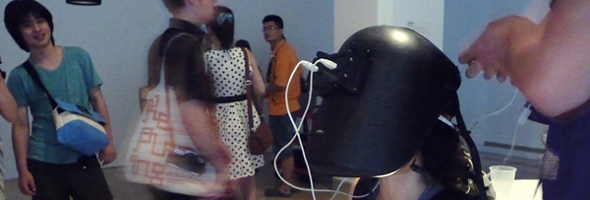
A person whose organs have evolved into USB Organs (sockets) is connected to cameras, microphones and speakers as sensory substitutes to feel his existence. If a future human being may not need a corporal body, at least his / her organs can be exchanged with electronic devices. We anticipate our body as a universal plug / sockets that can be utilized at any moment and at any place.
The performer wears a helmet that is equipped with a head mounted display and a microphone. A USB camera and microphone are also connected to the helmet, which function as tentacles to sense the external world. The performer experiences temporal and spatial dislocation via a pre-configured duration of time-lapse which determines the time difference caused by the two time streams: time obtained through the audio-visual senses within the helmet and the time projected from outside the helmet.
The performer wears a helmet that is equipped with a head mounted display and a microphone. A USB camera and microphone are also connected to the helmet, which function as tentacles to sense the external world. The performer experiences temporal and spatial dislocation via a pre-configured duration of time-lapse which determines the time difference caused by the two time streams: time obtained through the audio-visual senses within the helmet and the time projected from outside the helmet.
Mock-ups (videos of AR applications & implications)
Augmented (hyper) Reality (2010)
Keiichi Matsuda, UK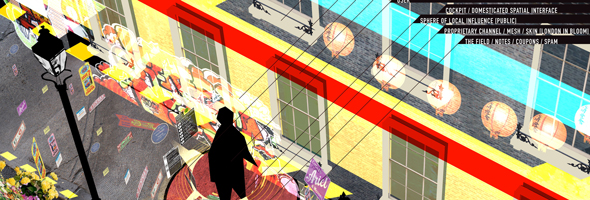
The architecture of the contemporary city is no longer concerned only with the physical space of buildings and landscapes; it becomes increasingly focused on the synthetic spaces created by the digital information that we collect, consume and organize. An immersive interface may become part of the world we inhabit as much as the buildings around us.
Augmented (hyper) Reality is an ongoing ‘research-by-design’ project by Keiichi Matsuda, which explores scenarios for our occupation of the city in the context of emerging technologies and ubiquitous media. The hyper-real mediascapes of the future city are depicted in two award-winning short films,Domestic Robocop and Augmented City 3D, which will be presented alongside production drawings. The films aim to provide a platform for a debate and a counterpoint to the utopias for the future promoted by numerous tech companies. They explore the implications for privacy, identity and the construction of space in a dynamic mediascape, with wide-ranging consequences on everyday life.
Augmented (hyper) Reality is an ongoing ‘research-by-design’ project by Keiichi Matsuda, which explores scenarios for our occupation of the city in the context of emerging technologies and ubiquitous media. The hyper-real mediascapes of the future city are depicted in two award-winning short films,Domestic Robocop and Augmented City 3D, which will be presented alongside production drawings. The films aim to provide a platform for a debate and a counterpoint to the utopias for the future promoted by numerous tech companies. They explore the implications for privacy, identity and the construction of space in a dynamic mediascape, with wide-ranging consequences on everyday life.
Mediating Mediums (2011)
Greg Tran, US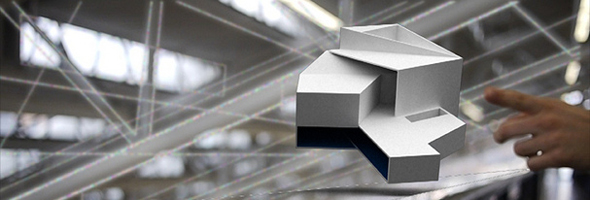
A recent graduate of the Harvard Graduate School of Design, Greg Tran’s thesis prize winning concept, Mediating Mediums, provides a thought-provoking glimpse into the future functionality and application of augmented reality. According to Tan, digital 3D is currently confused with the digital 2D representation of 3D material like that of Pixar animations or computer models. As he sees it, true digital 3D has potential to converge what is real and what is imagined, expressed here as a graphical user interface that exists not only within, but as architectural elements that provoke user interaction.
NGA Experience (2011)
Tate Strickland, US
The ubiquity of mobile devices and the advent of augmented reality provide an opportunity to explore the use of interactive design in what is traditionally a difficult educational space: the art museum. The NGA Experience app (shown here on an iPhone but theoretically platform-agnostic) uses augmented reality to populate the art museum with a digital layer of content that is virtually infinite, yet completely optional for visitors. Such an application of AR in the museum ultimately provides a greater level of control and engagement to the museum visitor and enhances his or her opportunity for a meaningful experience without altering the physical space of the gallery.
Sports++ (2011)
Sander Veenhof, NLProduced in collaboration with V2_Lab and Layar
Supported by the Dutch Gamefonds
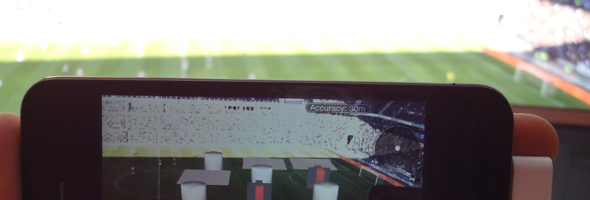
Transforming the sports stadium into an augmented reality arena is the goal of the Sports++ project, which is currently being developed by artist Sander Veenhof.
Sports++ will offer soccer fans worldwide an additional gaming layer on top of the action happening on the playing field. This additional action can be viewed using the Layar augmented reality browser, available for iPhone or Android smartphones. Spectators that point their smart phone camera onto the soccer field will be able to see an altered live image of the field, augmented with virtual gaming elements and characters. The ball, the players and/or the referee will be, with their movements and actions, unknowingly controlling the parallel game happening in the virtual universe.
Sports++ aims to fully connect the soccer players and their actions to the game characters living in the mixed reality game environment, to allow the audience to play an active role and to give supporters worldwide the power to get involved in the game in unique ways.
Sports++ will offer soccer fans worldwide an additional gaming layer on top of the action happening on the playing field. This additional action can be viewed using the Layar augmented reality browser, available for iPhone or Android smartphones. Spectators that point their smart phone camera onto the soccer field will be able to see an altered live image of the field, augmented with virtual gaming elements and characters. The ball, the players and/or the referee will be, with their movements and actions, unknowingly controlling the parallel game happening in the virtual universe.
Sports++ aims to fully connect the soccer players and their actions to the game characters living in the mixed reality game environment, to allow the audience to play an active role and to give supporters worldwide the power to get involved in the game in unique ways.
